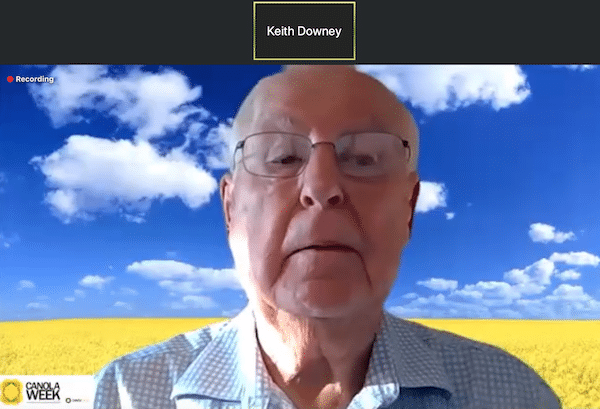Canola Week 2020 was an online event December 1-3 that merged Keith Downey’s Canola Industry Meeting, which provided updates on production, markets and the state of the industry, with the Canola Council of Canada’s Canola Discovery Forum, which had a 4R fertilizer management theme, and Canola Innovation Day, which updated on research and innovation.

Canola Week had 650 registrants, with up to 400 participating at any one time. Registration data show that 51 per cent were from research and development, 21 per cent were agronomists, 12 per cent industry, 10 per cent producers and six per cent sales. Geographically, 92 per cent were from Canada (almost all from the Prairie provinces) and six per cent were from the United States.
This article covers just a few of the highlights.
Yield robbers
StatCan’s December 3 yield estimates put canola at 40.1 bu./ac. for 2020, down from 41.4 in 2019 and the five-year (2016-20) average of 41.1. At Canola Discovery Forum, CCC agronomy specialist Justine Cornelsen presented on 2020 yield robbers. Big ones were hot weather at flowering, and the dry end to the season. Wind that delayed timely weed management meant increased and extended weed competition for some canola fields, which can cause major yield loss. Sclerotinia stem rot and excess moisture reduced yield in the northwest Prairies in particular, and flea beetles were a factor again – as usual. This Canola Watch article has more.
4R focus
Canola Discovery Forum had a 4R fertilizer management theme. The 4R principles are Right Source at the Right Time, Right Rate and Right Place. The Canola Council of Canada has a goal to have 90 per cent of canola acres implementing 4R practices by 2025. Fertilizer Canada’s latest grower survey found that currently 51.6 per cent of Canadian canola acres would qualify as 4R. More on counting acres.
The program included a panel with Lyle Cowell with Nutrien in Saskatchewan, Mario Tenuta with the University of Manitoba, Dean Nelson, who farms in Alberta, and Adam Gurr, who farms in Manitoba. The panel emphasized the importance of subsoil application of fertilizer. Mario Tenuta said, “I think subsoil banding is absolutely critical. The concentration of nutrients results in less interaction with the soil and means more availability to the plant. It is one of things farmers have some ability to control.” Dean Nelson talked about the importance of soil sampling so he knows what rates to use. Logistically, he says it’s easier to have one blend for canola for the farm, but with soil tests he can adjust the rate based on needs for each field. Adam Gurr talked about phosphorus rates that match crop removal, and added that farmers would really benefit from an accurate economic evaluation of phosphorus fertilizer rates. Lyle Cowell says the first thing farmers should do is figure out the appropriate rate based on the potential of the soil. The whole panel is captured in this Canola Watch podcast.
An interactive Menti poll gathered input from 201 participants, including 28 farmers. When asked for the first word they think of when they think of 4R, the most common reply was “sustainability”, followed by “efficiency”. When asked about barriers to 4R adoption, the top answer was “education” followed by “cost” and then “logistics”. The poll asked an open-ended question, “What practice(s) do you think will make the biggest difference in terms of improving fertilizer (nutrient use) efficiency?” The top answers were along the lines of this: We need more soil testing, and ideally some technology that allows for more rapid, on-the-go testing in combination with precision farming tools that can adjust based on variable needs throughout the field. The “right” hybrids, perhaps with traits for improved nutrient use efficiency, was another common answer. And of course costs – these investments need the potential to provide a return most years.
The complete Menti poll with questions and results:
Go here if you want to answer the Menti poll and help with the “discovery”.
Honourable mentions
A complete review of the three-day event would require a lot more space and writing, but here are a few noteworthy discoveries:
- University of Saskatchewan prof and researcher Fran Walley has funding for a new project to update the uptake and removal guidelines for Western Canadian crops, including hybrid canola.
- Integrated pest management practices put increasing emphasis on scouting, thresholds and benefits of biodiversity, which will be enhanced by a new grower-funded project on beneficial insects, their habitat and ecology.
- Venture capital investors are pouring billions of dollars into farming innovations in genetics, sensors, end use products and more.
